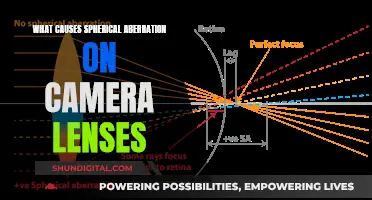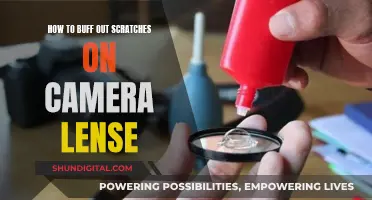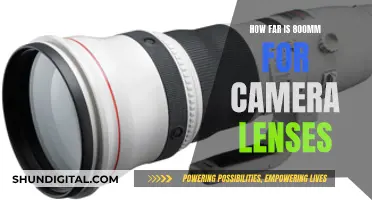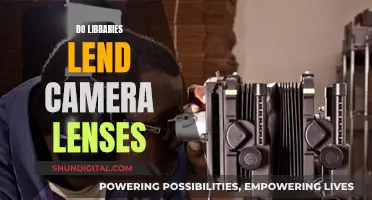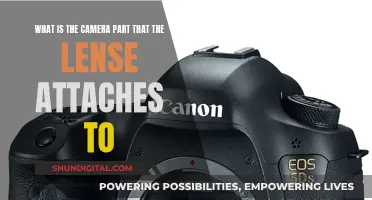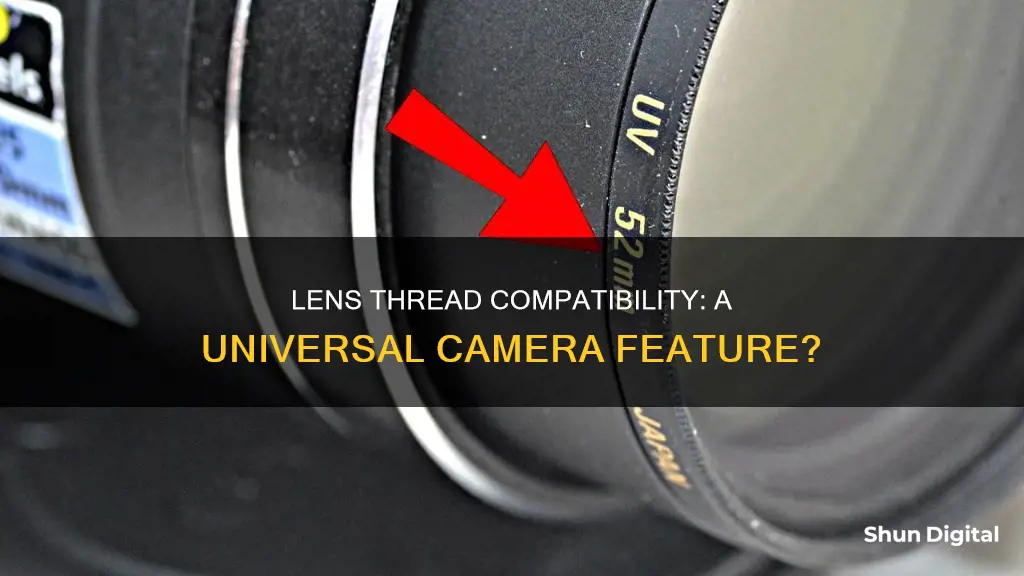
The compatibility of lenses with cameras depends on the type of lens thread and mount. Standardisation of lens threads is important as it allows for the changing of lenses independent of the manufacturer. Screw threads are the predecessors of bayonet connectors, which are now the dominant type of lens connection. Screw threads were mainly used until the 1980s, and some common types include M39, M40, and M42. The M39 screw thread, for example, was used in miniature cameras from the 1930s and offered by companies such as Leica, Voigtländer, Canon, and Ricoh. The M42 screw thread is a standardised connection used by camera brands such as Praktica, Pentax, and Fujica.
In addition to screw threads, other types of lens connections include bayonet mounts and C-mounts. Bayonet mounts are commonly used in professional video cameras and allow for easy lens swapping in the field. C-mounts, on the other hand, are standardised lens threads introduced in the 1920s for film technology and are still used today. They have an external diameter of 1 inch and a pitch of 1/32 inch.
When it comes to tripod threads, the DIN 4503 (Camera and Accessory Tripod Connections) standard is commonly used, although UNC threads are also similar and interchangeable. Two common tripod thread sizes are 1/4 - 20 UNC (small photography thread) and 3/8 - 16 UNC (large photography thread).
| Characteristics | Values |
|---|---|
| Tripod thread standards | DIN 4503, UNC thread |
| Tripod thread sizes | 1/4" - 20 UNC, 3/8" - 16 UNC |
| Lens thread types | M39, M40, M42, C-Mount, CS-Mount, S-Mount |
| Filter thread types | Coarse, fine |
What You'll Learn

The role of a tripod thread
The tripod thread is located on the mounting head of the tripod, which usually includes a thumbscrew that mates with a female-threaded receptacle on the camera. The mounting head also includes a mechanism to rotate and tilt the camera when it is attached to the tripod.
The tripod thread size that you need will depend on the size and weight of your camera. Most consumer cameras are fitted with 1/4-20 UNC threads, while larger professional cameras and lenses may be fitted with 3/8-16 UNC threads, plus a removable 1/4-20 UNC adapter. This allows them to be mounted on a tripod with either screw size.
It is important to note that not all tripod screws are the same size, and using the wrong screw can damage your camera or tripod. Additionally, while the thread profile of UNC and metric screws is the same, the mismatch of base units and pitch means that they are not compatible. Therefore, it is crucial to use the correct screw thread for your camera and tripod.
The High Cost of Camera Lenses: Why So Expensive?
You may want to see also

Tripod thread standards
The standard tripod thread is 1/4″ 20 pitch UNC Unified Coarse Thread (6.35mm outer diameter and 5.35mm core hole diameter). This is used on viewfinder cameras, rangefinder cameras, roll film cameras (also DSLRs) up to medium format cameras, quick release plates and tripod heads.
The other standard tripod thread is 3/8″ 16 pitch UNC Unified Coarse Thread (9.52mm outer diameter and 8.25mm core hole diameter). This is used on most medium format cameras and almost all large format cameras, as well as most connections between tripods and tripod heads.
The tripod thread is always a UNC coarse thread for historical reasons. It is mechanically more stable than a metric standard thread.
The two thread sizes are 1/4–20 UNC and 3/8–16 UNC. The "UNC" means the thread corresponds to a coarse thread, per the Unified Thread Standard (UTS), which is a 60° profile thread. The UTS is controlled by ASME/ANSI (US standards bodies).
The UTS is the same 60° thread profile as the ISO thread profile, but of course, UTS threads (such as the coarse UNC) are in fractional inches, as opposed to the metric thread size and pitch.
Even though 1/4–20 UNC and 3/8–16 UNC are imperial/inch sizes, ISO 1222:2010 recognises the universality of those threads in the photographic world, and thus, ISO 1222:2010 specifies 1/4–20 UNC and 3/8–16 UNC. So there isn't a "ISO/metric" equivalent in non-US or non-UK countries — 1/4–20 UNC and 3/8–16 UNC are the ISO standard.
The Myth of Circular Camera Lenses: Fact or Fiction?
You may want to see also

The lens thread: history and modern alternatives
The lens thread is a critical aspect of photography, ensuring the secure attachment of lenses to cameras. While the concept of lens threads has evolved over time, it remains a fundamental component of modern camera systems. The history of lens threads is closely tied to the development of photography and the pursuit of capturing sharper images.
History of Lens Threads
The origin of lens threads can be traced back to the early days of photography when photographers experimented with various methods of attaching lenses to cameras. The threaded lens and mount combinations emerged as a popular solution, offering convenience and versatility. Over time, standardisation took place, leading to the establishment of ISO (International Organization for Standardisation) threads.
ISO threads are defined by their nominal diameter, such as M8, M10, or M12, representing the common board-mount lens types. The thread diameter is measured in millimetres, with M12 being a prevalent choice for general-use lenses in applications like security, automotive, and video conferencing.
Modern Alternatives
While lens threads remain prevalent, modern alternatives have emerged to address specific challenges and push the boundaries of optical performance. Here are some contemporary options:
- Precision Mounting Concept: This approach addresses the issue of excessive "play" in the thread, which can compromise image quality. By reducing tip and tilt by up to 50%, the Precision Mounting Concept minimises the reliance on thread fit, eliminating the need for tight tolerances and individual fitting.
- Active Alignment (AA): Active Alignment offers a threadless solution for high-resolution imaging. It employs advanced technologies to align the lens precisely with the sensor, ensuring optimal optical performance, especially in mid-to-high volume and high-resolution applications.
- Sub-Assembly Solutions: Companies like Sunex provide sub-assembly services, assembling lenses to mounts in a controlled environment, reducing debris and ensuring a precise fit. This approach is particularly beneficial for mass-production applications.
In conclusion, the lens thread has evolved from basic threaded lens and mount combinations to more advanced systems that prioritise precision and performance. While lens threads remain a fundamental aspect of photography, modern alternatives offer enhanced solutions for specific applications, pushing the boundaries of image quality and technological innovation.
The Ultimate Camera Lenses for Professional Photography
You may want to see also

C-Mount and CS-Mount lens threads
C-mount and CS-mount are screw-threaded lens mounts commonly found in machine vision and surveillance cameras. They have the same thread pattern, with a 1-inch diameter and 32 threads per inch, but their flange focal distance (FFD) differs. The C-mount has an FFD of 17.526 mm, while the CS-mount has an FFD of 12.526 mm. Due to this difference, they are not directly interchangeable without an adapter.
The C-mount lens is directly compatible with the C-mount camera and can also be adapted for use with a CS-mount camera using a 5 mm spacer ring. However, the CS-mount lens cannot be used with a C-mount camera, as the shorter FFD of the CS-mount lens prevents it from being mounted close enough to the camera sensor to produce a focused image.
The C-mount is commonly used in machine vision applications and offers a wide range of lenses. The CS-mount, on the other hand, is often employed by manufacturers of surveillance cameras and cost-sensitive embedded vision applications. The shorter flange focal length of CS-mount lenses also makes them suitable for designing affordable extreme wide-angle lenses.
Cleaning Camera Lenses: A Step-by-Step Guide
You may want to see also

Filter threads
Almost all lenses have a threaded section at the front that allows you to screw on filters to achieve certain effects. The specifications of a lens should tell you the diameter of the filter thread, and you can then purchase filters in the same diameter. Common thread sizes include 52mm, 72mm, 77mm, and 82mm. If you want to use a filter with a lens that has a different filter thread diameter, you can use a step-down ring to adapt one diameter to another.
If you don't want to buy filters for all the different sizes of lenses you own, it is best to buy a filter to fit the largest lens and then use step-up rings to adapt the large filter to smaller lenses. You cannot really use a small filter on a lens with a larger diameter since the filter would become visible in the image.
The thread pitch, or the linear distance the filter travels for one or more full rotations of the thread, is also important. Metric threads are always specified per thread turn. Retail filter diameters between about 30mm and 86mm have a 0.75mm thread pitch. Below 30mm, the thread pitch is 0.5mm, and above 86mm, the thread pitch is 1mm.
How Lenses Transform Your Camera's Vision
You may want to see also
Frequently asked questions
A lens thread is a standardised adaptation device for changing lenses, independent of the manufacturer.
No, not all lens threads are compatible with all cameras. The compatibility depends on the camera mount thread.
Some examples of lens threads are the M39-Screw Thread, M40-Screw Thread, and M42-Screw Thread.
The compatibility of a lens thread with a camera depends on the thread diameter and pitch. The thread diameter is the outside diameter of the lens, typically denoted by the letter "M" followed by a number in millimetres. The pitch refers to the distance between the peaks or valleys of the thread teeth.
Yes, bayonet connectors are now the dominant method in the market. They allow for quicker lens changes with a single hand motion.



